Gait Phase Estimation Based on User–Walker Interaction Force
Abstract
:1. Introduction
2. Method for Asymmetric Gait Phase Estimation
2.1. Architecture
2.2. BMFLC
2.3. AO
2.4. Adaptive Rules for Transient Parameters
2.4.1. Switching Mechanism
2.4.2. Adaptive Rule for a Parameter
3. Simulation
3.1. Simulation Scenario 1
3.2. Simulated Scenario 2
4. Experiment
4.1. Experiment Platform
4.2. Experiment Protocol
4.3. Data Analysis
4.4. Results
5. Discussion
6. Conclusions and Future Work
- 1
- The application of the proposed method for people who suffer from severe motor impairments will be further investigated;
- 2
- The application of the proposed method for actual wheel walker users under different conditions (straight and curve walking) will be further investigated;
- 3
- The interaction forces to be detected at both sides will be used to minimize the influence of misdetections of HSs (heel strikes).
Author Contributions
Funding
Institutional Review Board Statement
Informed Consent Statement
Data Availability Statement
Acknowledgments
Conflicts of Interest
Abbreviations
| HS | Heel Strike |
| AO | Adaptive Oscillator |
| BMFLC | Band-limited Multiple Fourier Combiner |
| RMSE | Root Mean Square Error |
References
- Aboutorabi, A.; Arazpour, M.; Bahramizadeh, M.; Hutchins, S.W.; Fadayevatan, R. The effect of aging on gait parameters in able-bodied older subjects: A literature review. Aging Clin. Exp. Res. 2016, 28, 393–405. [Google Scholar] [CrossRef]
- Thibaud, M.; Bloch, F.; Tournoux-Facon, C.; Breque, C.; Rigaud, A.S.; Dugue, B.; Kemoun, G. Impact of physical activity and sedentary behaviour on fall risks in older people: A systematic review and meta-analysis of observational studies. Eur. Rev. Aging Phys. Act. 2012, 9, 5–15. [Google Scholar] [CrossRef] [Green Version]
- Stevens, J.A.; Powell, K.E.; Smith, S.M.; Wingo, P.A.; Sattin, R.W. Physical activity, functional limitations, and the risk of fall-related fractures in community-dwelling elderly. Ann. Epidemiol. 1997, 7, 54–61. [Google Scholar] [CrossRef]
- Page, S.; Saint-Bauzel, L.; Rumeau, P.; Pasqui, V. Smart walkers: An application-oriented review. Robotica 2017, 35, 1243–1262. [Google Scholar] [CrossRef] [Green Version]
- Yamada, K.; Yokoya, M.; Yamada, Y. Proposal of walking assistant robot for the elderly which is intended for use in home. IEICE Tech. Rep. 2016, 116, 25–30. (In Japanese) [Google Scholar]
- Ballesteros, J.; Urdiales, C.; Martinez, A.B.; Tirado, M. Automatic Assessment of a Rollator-User’s Condition during Rehabilitation Using the i-Walker Platform. IEEE Trans. Neural Syst. Rehabil. Eng. 2017, 25, 2009–2017. [Google Scholar] [CrossRef]
- Werner, C.; Chalvatzaki, G.; Papageorgious, X.S.; Tzafestas, C.S.; Bauer, J.M.; Hauer, K. Assessing the concurrent validity of a gait analysis system integrated into a smart walker in older adults with gait impairments. Clin. Rehabil. 2019, 33, 1682–1687. [Google Scholar] [CrossRef]
- Alwan, M.; Wasson, G.; Sheth, P.; Ledoux, A.; Huang, C. Passive derivation of basic walker-assisted gait characteristics from measured forces and moments. In Proceedings of the 26th Annual International Conference of the IEEE Engineering in Medicine and Biology Society, San Francisco, CA, USA, 1–5 September 2004. [Google Scholar] [CrossRef]
- Alwan, M.; Ledoux, A.; Wasson, G.; Sheth, P.; Huang, C. Basic walker-assisted gait characteristics derived from forces and moments exerted on the walker’s handles: Results on normal subjects. Med. Eng. Phys. 2007, 29, 380–389. [Google Scholar] [CrossRef]
- Abellanas, A.; Frizera, A.; Ceres, R.; Gallego, J.A. Estimation of gait parameters by measuring upper limb-walker interaction forces. Sensors Actuators Phys. 2010, 162, 276–283. [Google Scholar] [CrossRef]
- Li, P.; Yamada, Y.; Wan, X.; Uchiyama, Y.; Sato, W.; Yamada, K.; Yokoya, M. Gait-phase-dependent control using a smart walker for physical training. In Proceedings of the 2019 IEEE 16th International Conference on Rehabilitation Robotics (ICORR), Toronto, ON, Canada, 24–28 June 2019. [Google Scholar] [CrossRef]
- Yan, T.; Cempini, M.; Oddo, C.M.; Vitiello, N. Review of assistive strategies in powered lower-limb orthoses and exoskeletons. Robot. Auton. Syst. 2015, 64, 120–136. [Google Scholar] [CrossRef]
- Lewis, C.L.; Ferris, D.P. Invariant hip moment pattern while walking with a robotic hip exoskeleton. J. Biomech. 2011, 44, 789–793. [Google Scholar] [CrossRef] [Green Version]
- Zhang, Y.; Nolan, K.J.; Zanotto, D. Oscillator-based transparent control of an active/semiactive ankle-foot orthosis. IEEE Robot. Autom. Lett. 2011, 4, 247–253. [Google Scholar] [CrossRef]
- Ronsse, R.; Lenzi, T.; Vitiello, N.; Koopman, B.; van Asseldonk, E.; De Rossi, S.M.; van den Kieboom, J.; van der Kooij, H.; Carrozza, M.C.; Ijspeert, A.J. Oscillator-based assistance of cyclical movements: Model-based and model-free approaches. Med. Biol. Eng. Comput. 2011, 49, 1173–1185. [Google Scholar] [CrossRef]
- Righetti, L.; Buchli, J.; Ijspeert, A.J. Dynamic Hebbian learning in adaptive frequency oscillators. Phys. D Nonlinear Phenom. 2006, 216, 269–281. [Google Scholar] [CrossRef] [Green Version]
- Righetti, L.; Buchli, J.; Ijspeert, A.J. Adaptive Frequency Oscillators and Applications. Open Cybern. Syst. J. 2009, 3, 64–69. [Google Scholar] [CrossRef] [Green Version]
- Yan, T.; Parri, A.; Ruiz Garate, V.; Cempini, M.; Ronsse, R.; Vitiello, N. An oscillator-based smooth real-time estimate of gait phase for wearable robotics. Auton. Robot. 2017, 41, 759–774. [Google Scholar] [CrossRef]
- Nachstedt, T.; Tetzlaff, C.; Manoonpong, P. Fast Dynamical Coupling Enhances Frequency Adaptation of Oscillators for Robotic Locomotion Control. Front. Neurorobot. 2017, 11–14. [Google Scholar] [CrossRef] [Green Version]
- Zhao, J.; Iwasaki, T. Orbital Stability Analysis for Perturbed Nonlinear Systems and Natural Entrainment via Adaptive Andronov-Hopf Oscillator. IEEE Trans. Autom. Control 2020, 65, 87–101. [Google Scholar] [CrossRef]
- Patterson, K.K.; Parafianowicz, I.; Danells, C.J.; Closson, V.; Verrier, M.C.; Staines, W.R.; Black, S.E.; McIlroy, W.E. Gait asymmetry in community-ambulating stroke survivors. Arch. Phys. Med. Rehabil. 2008, 89, 304–310. [Google Scholar] [CrossRef]
- Frizera Neto, A.; Gallego, J.A.; Rocon, E.; Pons, J.L.; Ceres, R. Extraction of user’s navigation commands from upper body force interaction in walker assisted gait. Biomed. Eng. Online 2010, 9, 37. [Google Scholar] [CrossRef] [Green Version]
- Veluvolu, K.C.; Wang, Y.; Kavuri, S.S. Adaptive estimation of EEG-rhythms for optimal band identification in BCI. J. Neurosci. Methods 2012, 203, 163–172. [Google Scholar] [CrossRef] [PubMed]
- Xiao, F.; Gao, Y.; Wang, S.; Zhao, J. Prediction of pathological tremor using adaptive multiple oscillators linear combiner. Biomed. Signal Process. Control 2016, 27, 77–86. [Google Scholar] [CrossRef]
- Narendra, K.S.; Balakrishnan, J. Improving Transient Response of Adaptive Control Systems using Multiple Models and Switching. IEEE Trans. Autom. Control 1994, 39, 1861–1866. [Google Scholar] [CrossRef]
- Branicky, M.S. Lyapunov functions and other analysis tools for switched and hybrid systems. IEEE Trans. Autom. Control 1998, 43, 475–482. [Google Scholar] [CrossRef] [Green Version]
- Westervelt, E.R.; Grizzle, J.W.; Canudas de Wit, C. Switching and PI control of walking motions of planar biped walkers. IEEE Trans. Autom. Control 2002, 48, 308–312. [Google Scholar] [CrossRef]
- Cerny, K.; Perry, J.; Walker, J.M. Adaptations during the stance phase of gait for simulated flexion contractures at the knee. Orthopedics 1994, 17, 501–512. [Google Scholar] [CrossRef]
- Harato, K.; Nagura, T.; Matsumoto, H.; Otani, T.; Toyama, Y.; Suda, Y. A gait analysis of simulated knee flexion contracture to elucidate knee-spine syndrome. Gait Posture 2008, 28, 687–692. [Google Scholar] [CrossRef]
- Perry, J.; Burnfield, J.M. Gait Analysis: Normal and Pathological Function, 2nd ed.; Slack Inc.: New York, NY, USA, 2010. [Google Scholar]
- Karimi Ghartemani, M.; Khajehoddin, S.A.; Jain, P.K.; Bakhshai, A. Problems of Startup and Phase Jumps in PLL Systems. IEEE Trans. Power Electron. 2012, 27, 1830–1838. [Google Scholar] [CrossRef]
- Yang, S.; Zhang, J.T.; Novak, A.C.; Brouwer, B.; Li, Q. Estimation of spatio-temporal parameters for post-stroke hemiparetic gait using inertial sensors. Gait Psoture 2013, 37, 354–358. [Google Scholar] [CrossRef]
- Ballesteros, J.; Urdiales, C.; Martinez, A.B.; van Dieën, J.H. On Gait Analysis Estimation Errors Using Force Sensors on a Smart Rollator. Sensors 2016, 16, 1896. [Google Scholar] [CrossRef] [Green Version]
- Goldie, P.A.; Matyas, T.A.; Evans, O.M. Gait after stroke: Initial deficit and changes in temporal patterns for each gait phase. Arch. Phys. Med. Rehabil. 2001, 82, 1057–1065. [Google Scholar] [CrossRef] [PubMed]
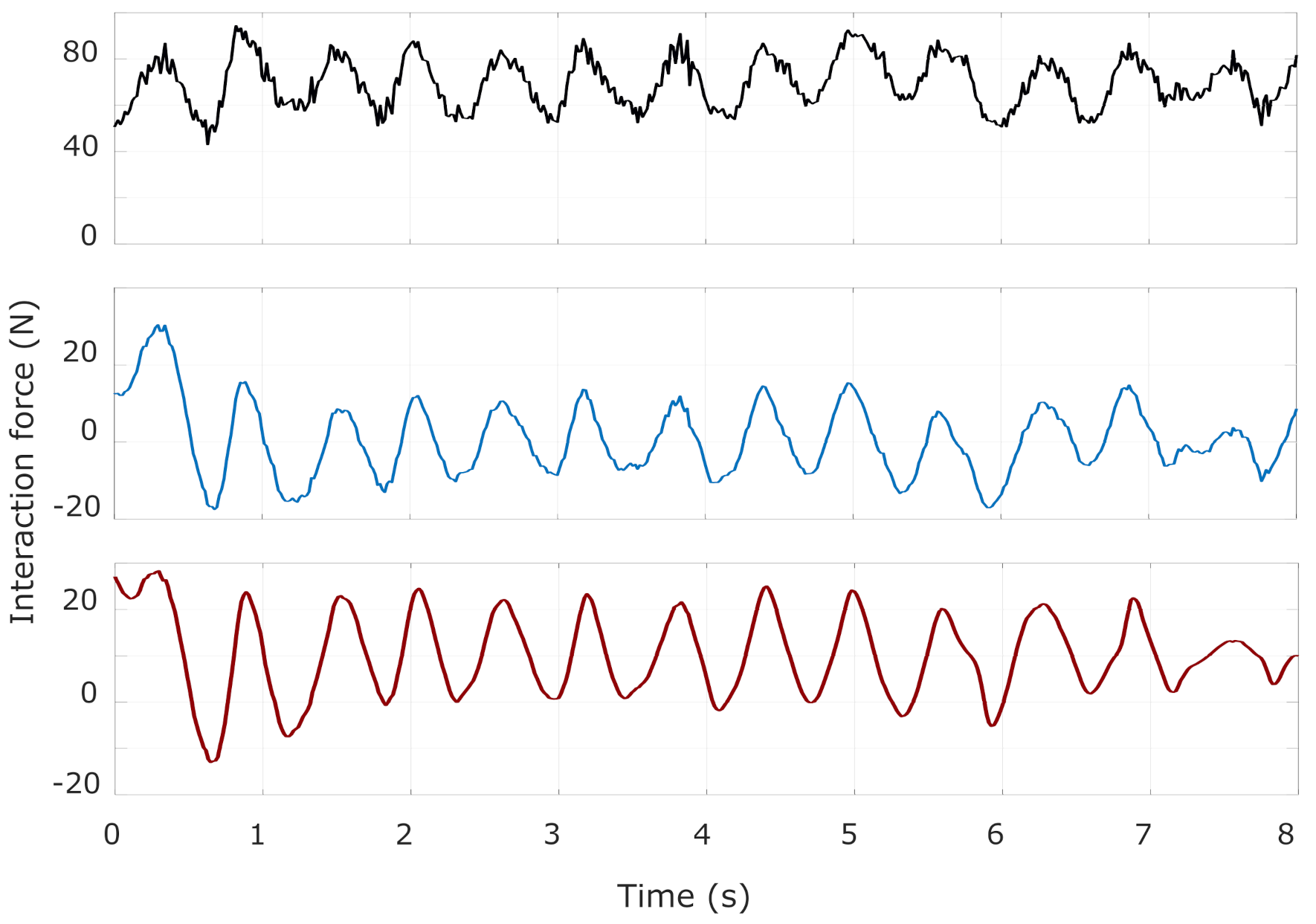

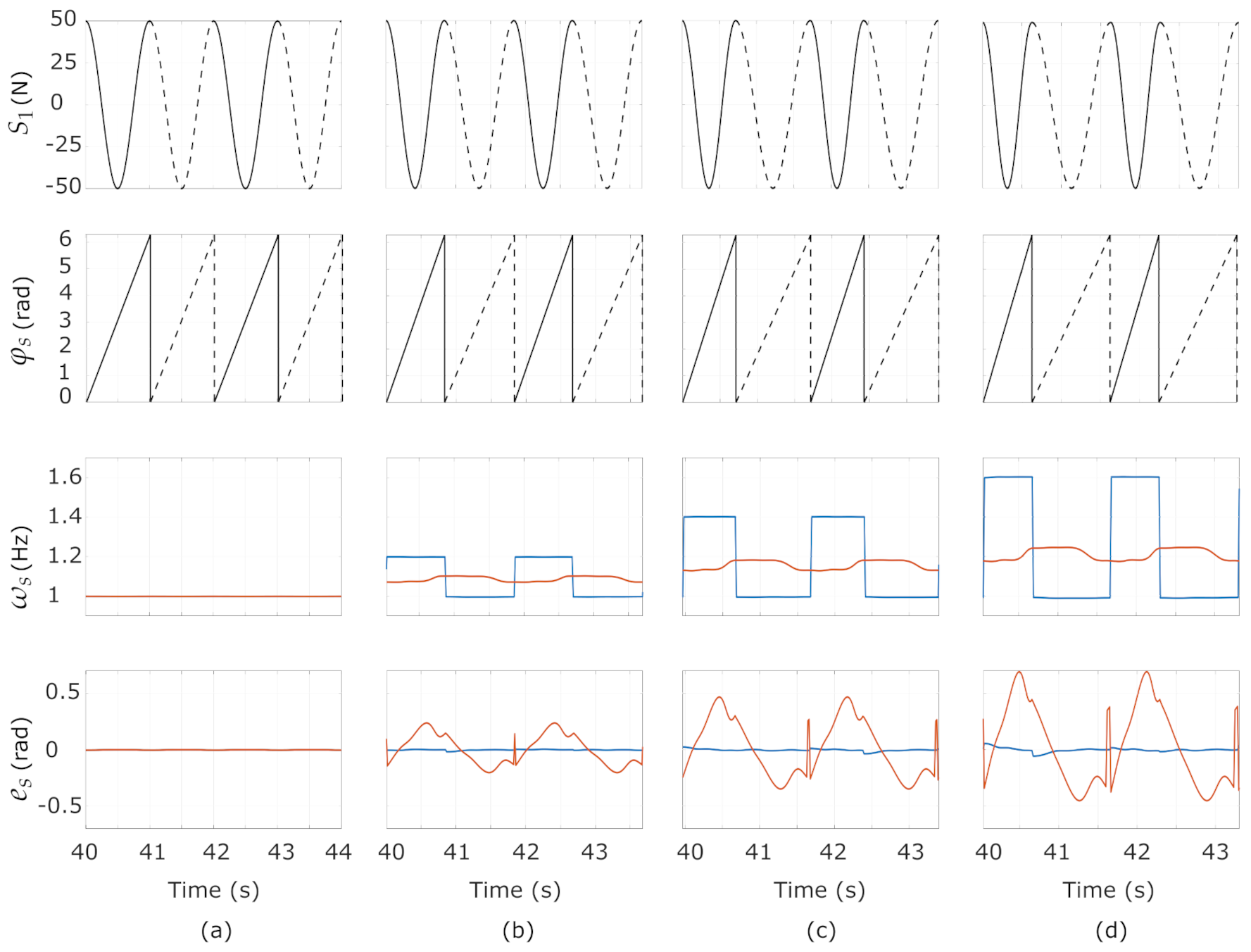
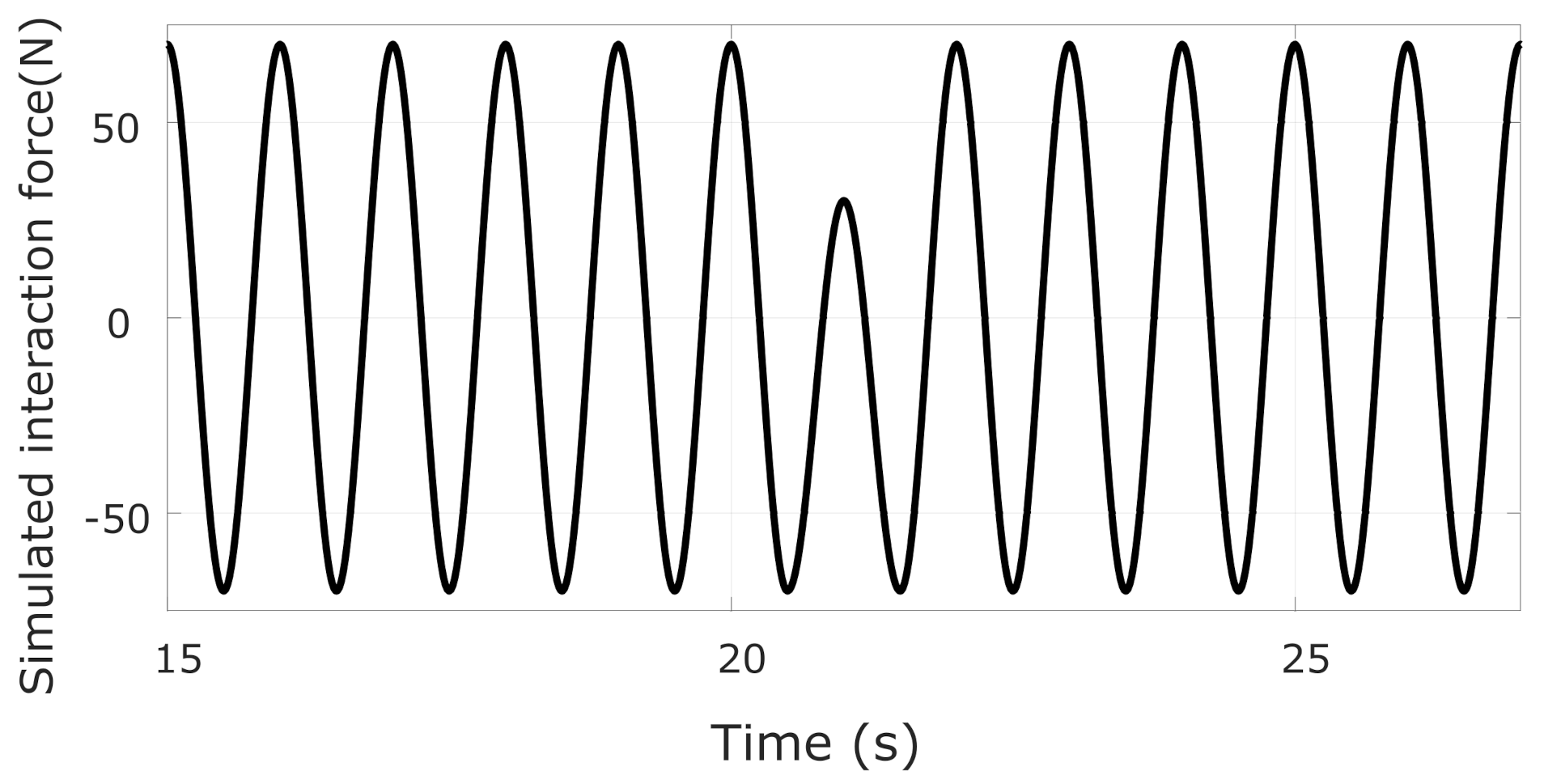
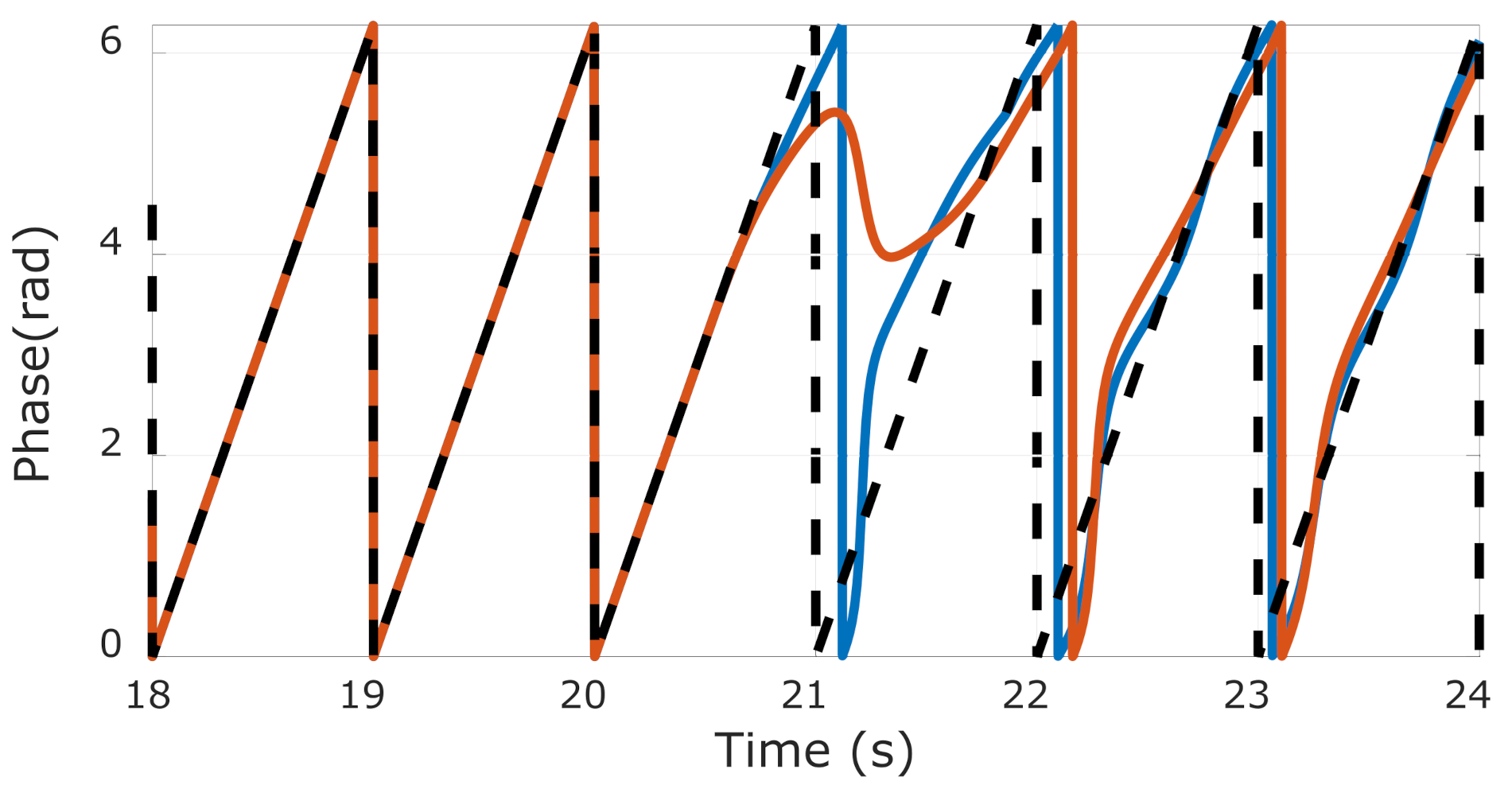
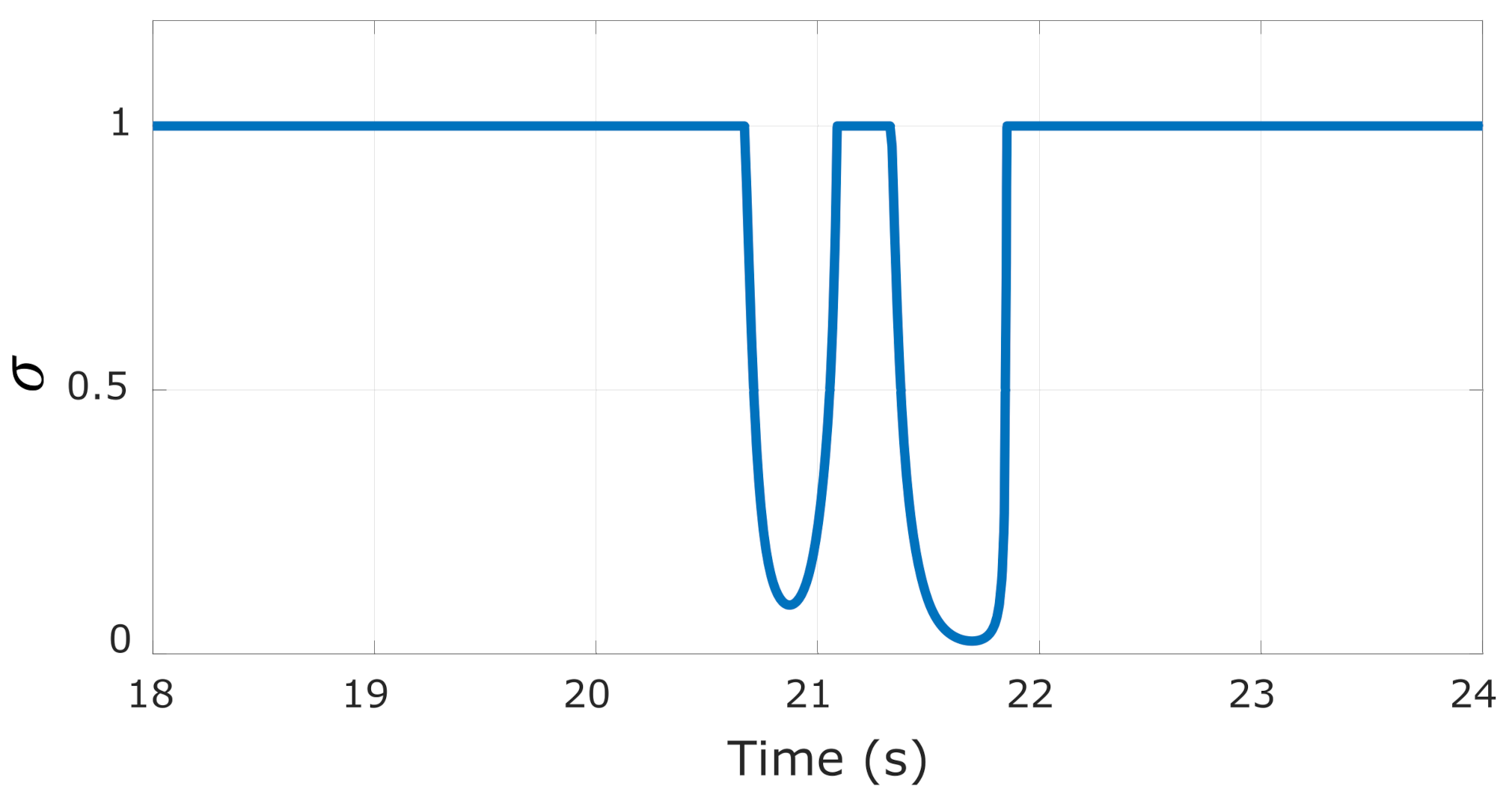
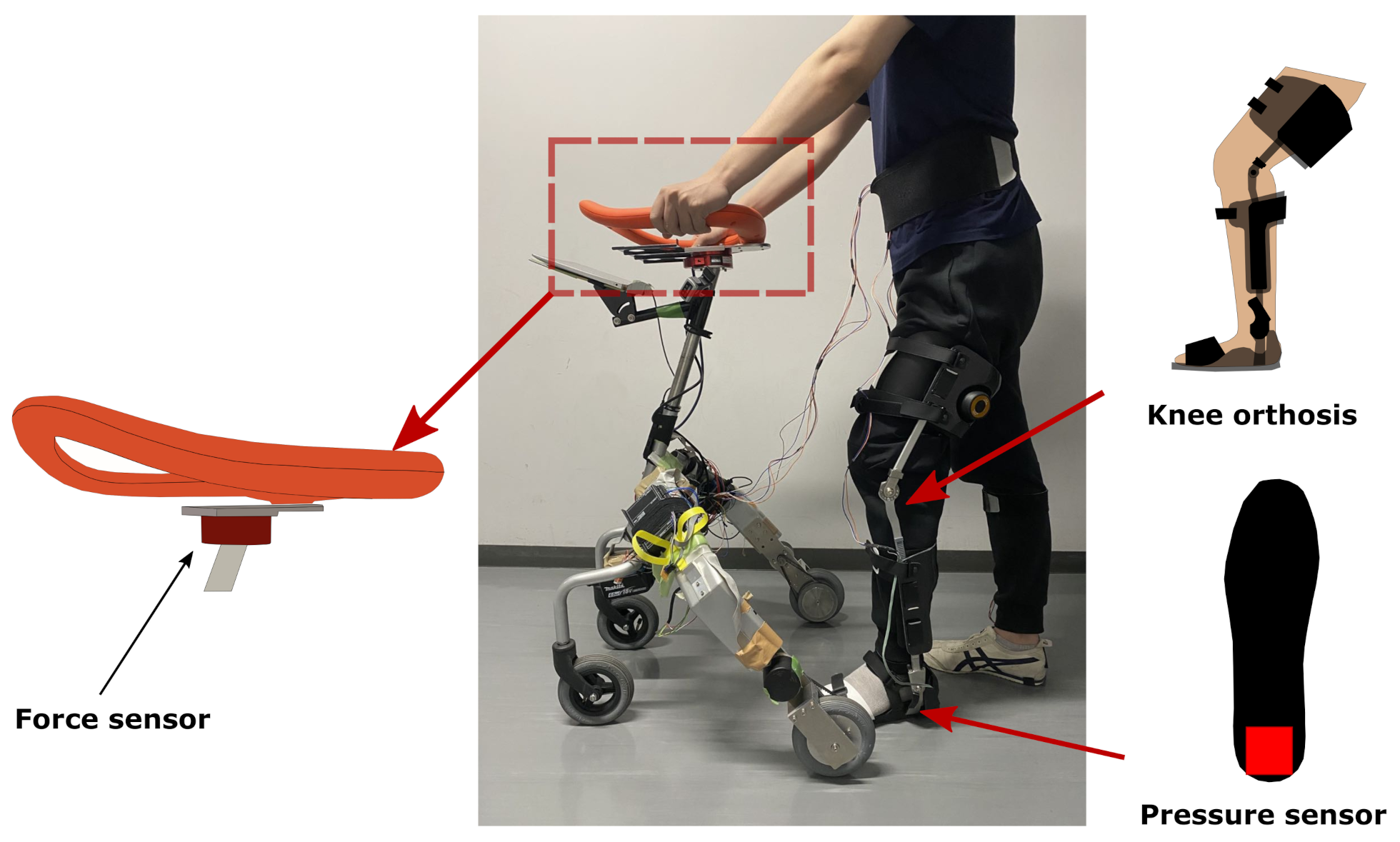
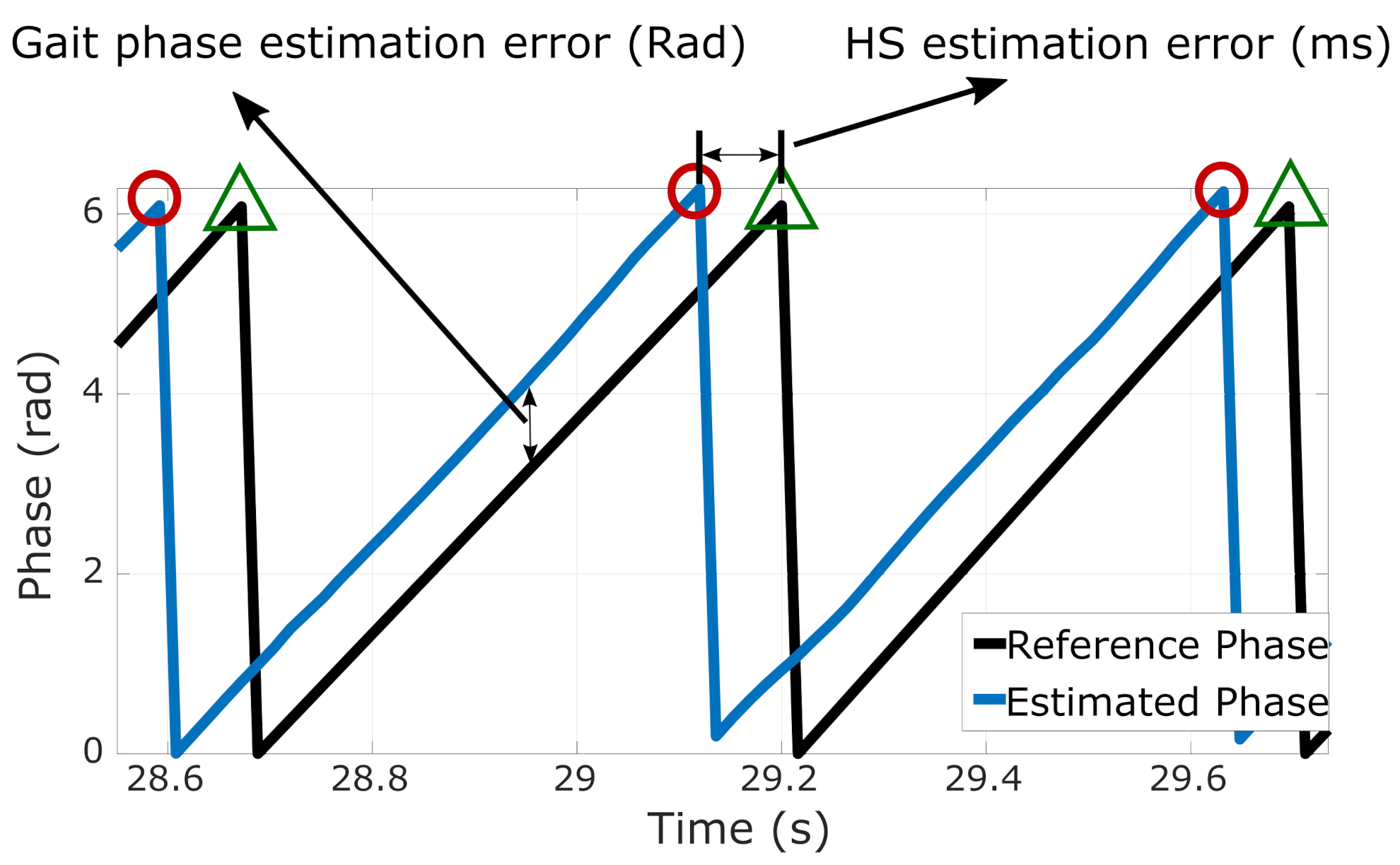
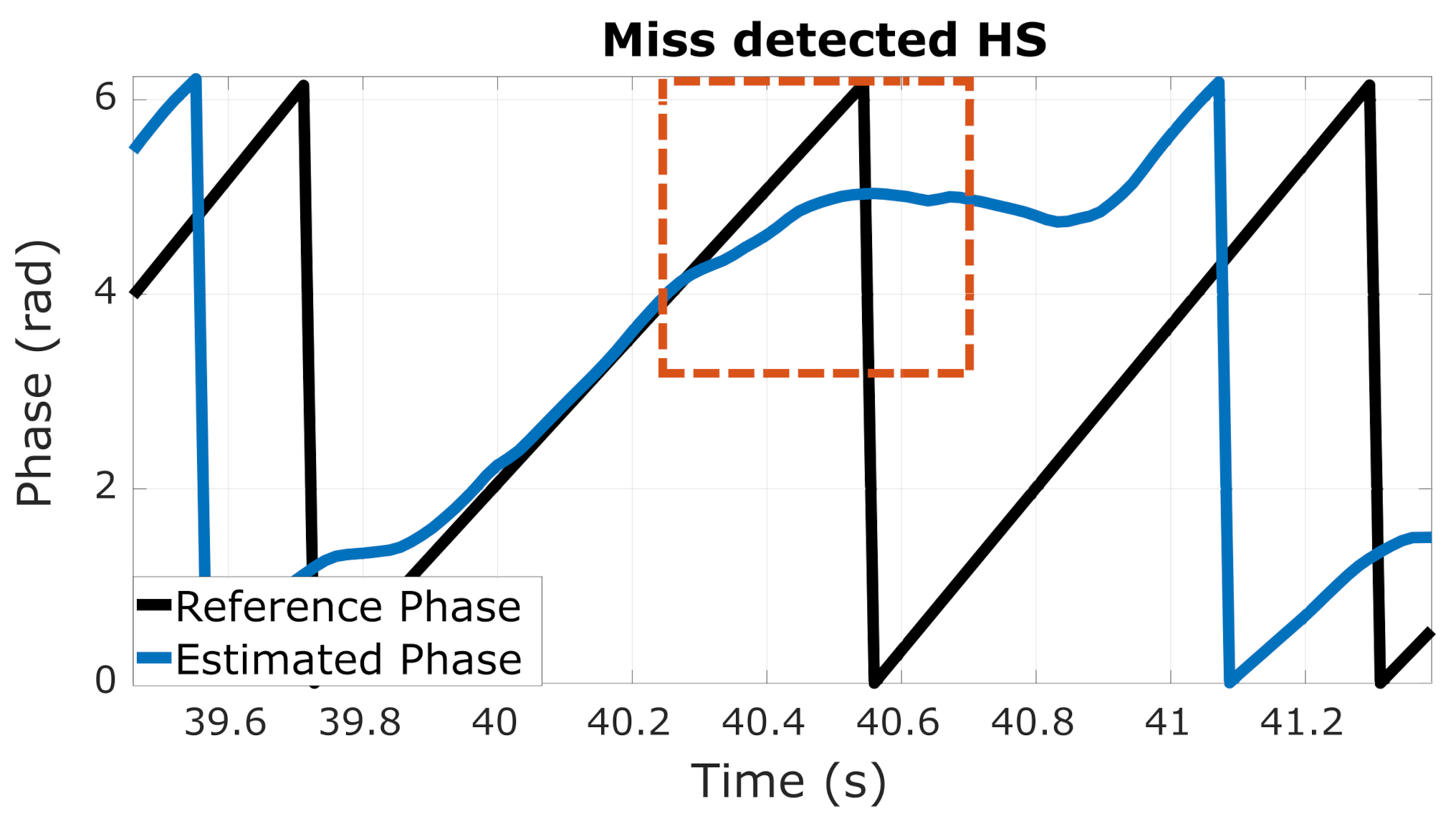
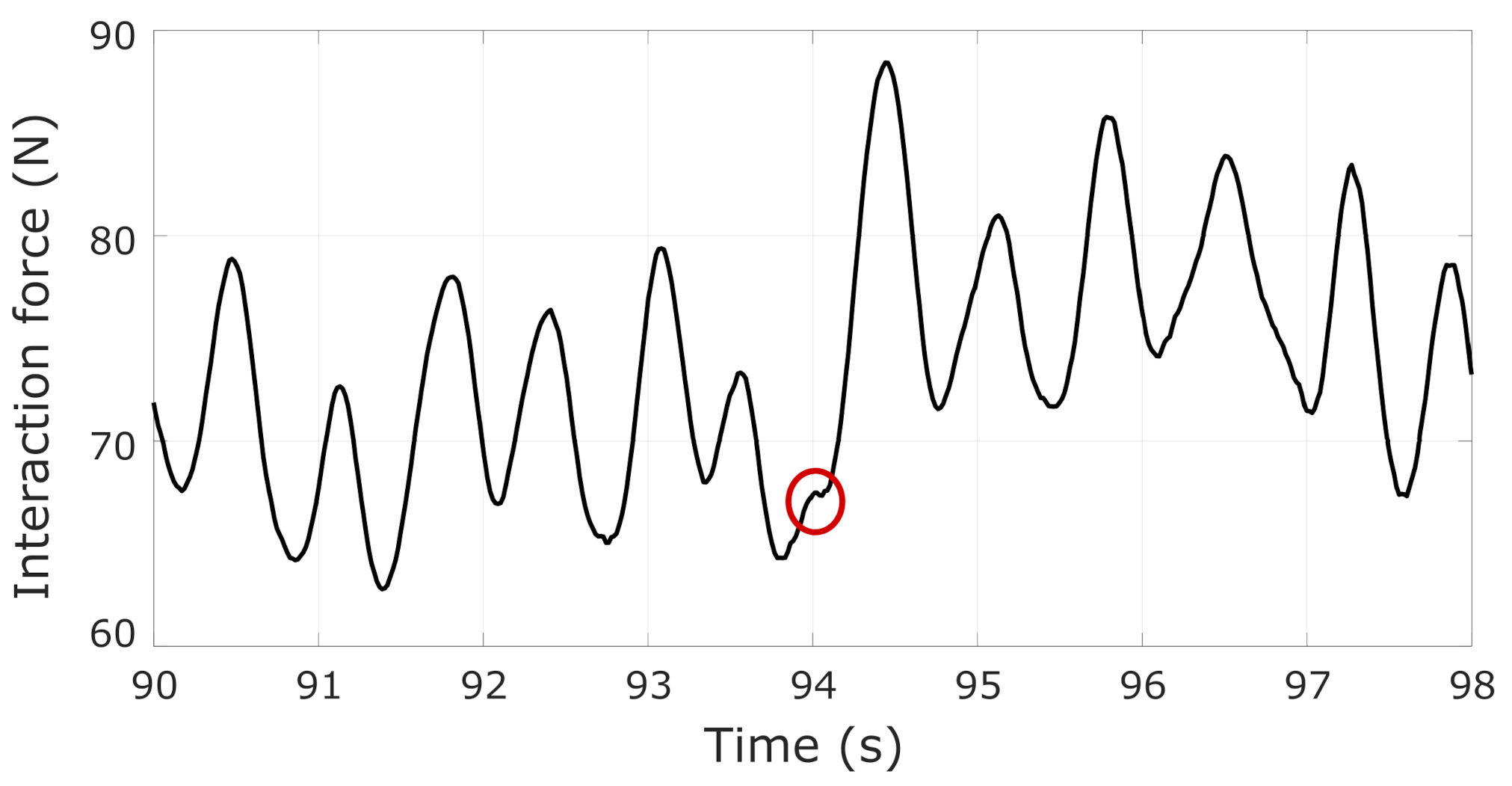
| Name of Method | Gait Phase Estimation Error (RMSE) | HS Estimation Error | No. HS Misdetections (Ratio *) |
|---|---|---|---|
| AO | 0.774 rad | 54.16 ± 53.28 ms | 35 (1.21%) |
| Proposed method | 0.691 rad | 55.75 ± 56.55 ms | 4 (0.14%) |
| Name of Method | Gait Phase Estimation Error (RMSE) | HS Estimation Error | No. HS Misdetections (Ratio *) |
|---|---|---|---|
| AO | 0.889 rad | 80.61 ± 70.39 ms | 105 (3.31%) |
| Proposed method | 0.722 rad | 75.79 ± 66.69 ms | 11 (0.35%) |
Publisher’s Note: MDPI stays neutral with regard to jurisdictional claims in published maps and institutional affiliations. |
© 2021 by the authors. Licensee MDPI, Basel, Switzerland. This article is an open access article distributed under the terms and conditions of the Creative Commons Attribution (CC BY) license (https://creativecommons.org/licenses/by/4.0/).
Share and Cite
Li, P.; Akiyama, Y.; Wan, X.; Yamada, K.; Yokoya, M.; Yamada, Y. Gait Phase Estimation Based on User–Walker Interaction Force. Appl. Sci. 2021, 11, 7888. https://doi.org/10.3390/app11177888
Li P, Akiyama Y, Wan X, Yamada K, Yokoya M, Yamada Y. Gait Phase Estimation Based on User–Walker Interaction Force. Applied Sciences. 2021; 11(17):7888. https://doi.org/10.3390/app11177888
Chicago/Turabian StyleLi, Pengcheng, Yasuhiro Akiyama, Xianglong Wan, Kazunori Yamada, Mayu Yokoya, and Yoji Yamada. 2021. "Gait Phase Estimation Based on User–Walker Interaction Force" Applied Sciences 11, no. 17: 7888. https://doi.org/10.3390/app11177888
APA StyleLi, P., Akiyama, Y., Wan, X., Yamada, K., Yokoya, M., & Yamada, Y. (2021). Gait Phase Estimation Based on User–Walker Interaction Force. Applied Sciences, 11(17), 7888. https://doi.org/10.3390/app11177888






